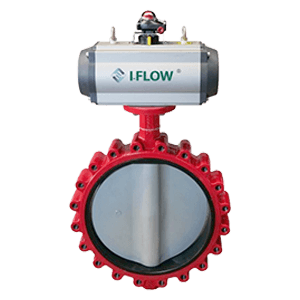In this article, we’ll explore why butterfly valves are suitable for compressed air, the technical factors to keep in mind, and how reliable manufacturers like I-FLOW ensure performance and safety.
Why Use Butterfly Valves for Compressed Air
Butterfly valves are quarter-turn valves that use a disc to regulate or isolate flow. They are widely used across industries and offer several advantages when applied to compressed air lines, including:
1. Fast and Efficient Operation
Because butterfly valves operate with a simple 90-degree rotation, they allow quick shut-off and flow adjustment, which is essential in compressed air systems that require responsive control.
2. Compact and Lightweight Design
In systems where space and weight are at a premium—such as onboard marine vessels or in portable compressed air units—the compact form factor of butterfly valves makes them an ideal choice.
3. Cost-Effective Control
Compared to globe valves or ball valves, butterfly valves offer a more affordable solution, especially in larger sizes. This makes them economically advantageous for high-volume air pipelines and pneumatic systems.
Where Are Butterfly Valves Used in Compressed Air Systems
-
①Main air distribution lines on vessels
-
②Pneumatic tools and automation systems
-
③Air reservoirs and compressors
-
④Ventilation and HVAC systems
-
⑤Bulk material handling (via air-powered equipment)
- ⑥Shipboard auxiliary machinery systems
Key Considerations for Butterfly Valves in Compressed Air Applications
1. Pressure Ratings
Not all butterfly valves are created equal. It’s crucial to select a valve that is rated for the pressure level in your compressed air system. For medium- to high-pressure air, opt for double-offset or high-performance butterfly valves.
2. Material Compatibility
Compressed air systems may contain traces of moisture, oil, or particulates. This can degrade inferior materials over time. Ensure the valve body, disc, and seals are made from corrosion-resistant materials such as stainless steel or bronze, and elastomers like EPDM, Viton, or PTFE.
3. Tight Shut-Off
Standard butterfly valves are not always bubble-tight, which can lead to air leaks—especially in critical applications. To minimize leakage, consider valves with resilient or metal seats that ensure a more reliable seal under pressure.
4. Actuation and Automation
Butterfly valves used in compressed air systems can be manually operated or automated using pneumatic or electric actuators. For precision and ease of remote control, butterfly valves paired with pneumatic actuators are often the most efficient in compressed air networks.
Why Choose I-FLOW for Your Butterfly Valve Needs
As a leading marine and industrial valve manufacturer, Qingdao I-FLOW specializes in producing high-performance butterfly valves engineered to withstand the demanding conditions of compressed air, steam, gas, and water systems.With more than 10 years of experience serving over 40 countries, I-FLOW valves are trusted in marine applications, HVAC systems, oil & gas plants, and water treatment facilities.
I-FLOW Butterfly Valves Are:
-
①Available in wafer, lug, and flanged types
-
②Constructed from durable materials like cast iron, ductile iron, stainless steel, and bronze
-
③Compatible with various sealing materials to match application needs (EPDM, NBR, PTFE, etc.)
-
④Tested to international standards including ISO, CE, and DNV
-
⑤Customizable with manual or automatic actuators
Post time: Jun-19-2025

